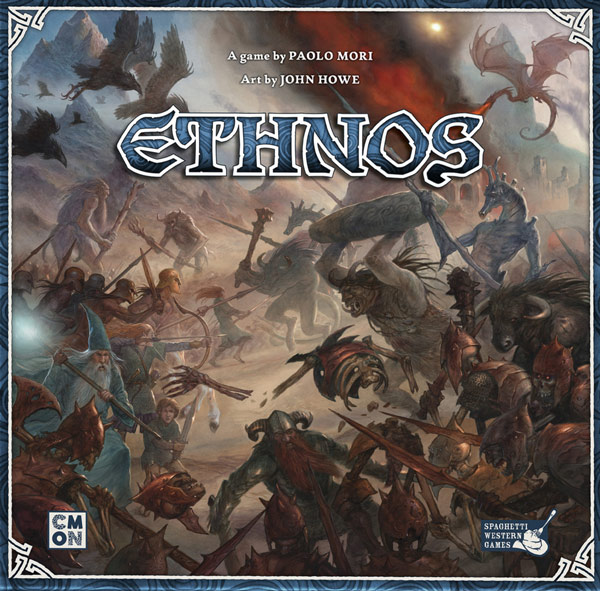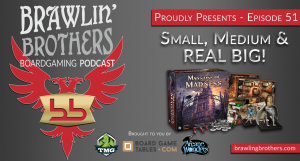Ethnos Review
Let’s try a thought experiment real quick. Close your eyes (figuratively of course). I want you to imagine a brand new game. It’s an area control card game published by Cool Mini Or Not. The game is set on a mystical fantasy continent where several fantasy races struggle to forge an alliance so that they can rule the land. That sounds awesome, right? CMON has a great track records for gorgeous overproduced games with solid designs and excellent integration of story and setting. Whatever you were imagining, it is nothing like what Ethnos turns out to be.
Ethnos as a product is a very odd duck. It comes off as something completely unexpected from CMON, and it does this in ways that are both huge disappointments and delightful surprises. If I had to give just one word to describe Ethnos, it would be subtle. This is of course the last thing you would expect from a CMON title, as pretty much every game they produce jumps out at the audience with a huge fanfare punctuated by neon lights. Allow me to elaborate …
Ethnos is in truth a dressed up rummy-style game. I say this as a way of tempering expectations and not as a pejorative. If you’ve played any of Mike Fitzgerald’s (wonderful and often overlooked) Mystery Rummy games, you have a pretty good idea of what you can expect from Ethnos. Your turn is paired down to either drawing or playing cards in an effort to build sets of cards based on value or suit in order to score points. What Mike Fitzgerald accomplished in his Mystery Rummy series was to make classic Rummy into a “gamers game” by giving cards special powers when played. I’ve always viewed the Ticket to Ride series as a step backwards from the Mystery Rummy games; TTR never caught on with me because Mystery Rummy was always a more enjoyable and “gamerly” experience. Ethnos, though, separates itself from its roots in the Mystery Rummy series in two very important ways.
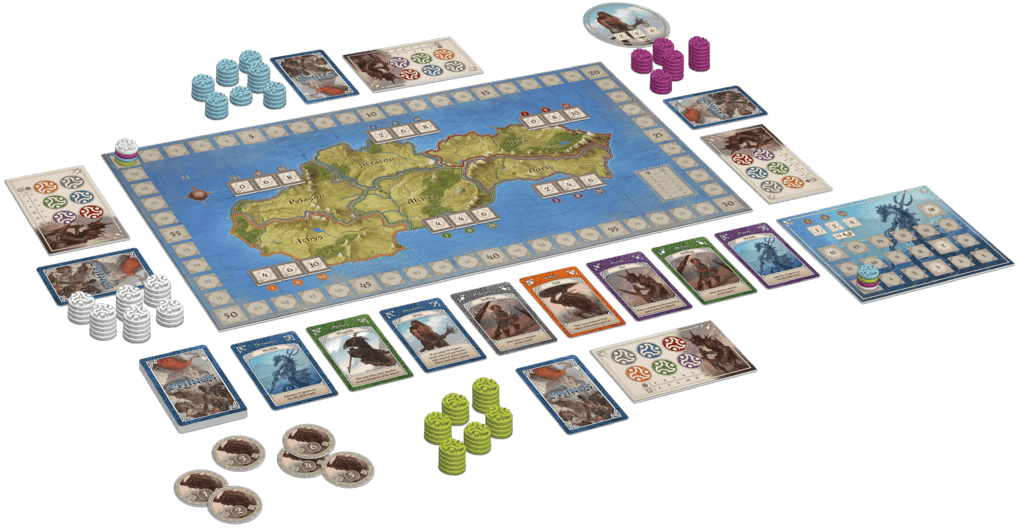
First, much like in TTR, Ethnos integrates a board game element. Unlike TTR though, Ethnos’ area control map isn’t the game itself, but rather is an element that is added onto the core bones of the rummy style card game that is the true heart of Ethnos. This is another extremely counter intuitive part of Ethnos; it’s an area control game where the area control aspect is often times only a side element of the game. In truth, Ethnos is a card game with an area control sideboard. You can win this game without ever challenging the control of any region on the board (although it can be very tricky).
Second, Ethnos introduces the idea of a completely randomized (or customizable) rummy deck for each game as a way of increasing replayability. Every game of Mystery Rummy you play is going to use the same deck for the same individual game. The decks never change. Ethnos, however, figures out how to turn this idea completely on its head. In any given game, players will have access to only 5 or 6 of the 12 available suits (races). Each suit (race) has its own unique power that is triggered when played as the lead of a set of cards. The ways the 5 or 6 suits interact with one another can have HUGE results in the emergent qualities of the game play. Each different race changes the core game play in some fundamental way. These changes can shift attention/value towards or away from the game board. It can affect the basic strategies of the game (do I pursue fewer large sets, or several smaller sets?). And it can even affect the basic rhythms of the game play by influencing the speed at which players burn through the deck, or how they pursue collecting sets. The end result is that the game becomes extremely variable over repeated plays. The game simply feels like a unique game with each play, in much the same way that games with variable card markets often do (think Dominion or Thunderstone). Each game offers a neat little puzzle that will likely be different from most other games of Ethnos you’ve played.
So, in what aspects does Ethnos disappoint?
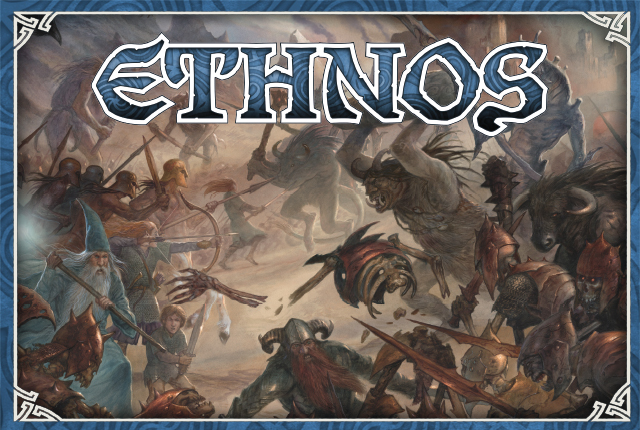 As an area control game, Ethnos is perhaps a bit tighter and more restrictive then I would normally prefer. Players can only place control markers in areas when they can play sets of cards that correspond to the given area. The problem with this is that while it is very easy to put down one or two markers in any given area, things become much more difficult to get larger runs as each of the three ages progress. At some points, it felt like I was stuck fighting over areas that I was either lucky enough to draw from the deck, or limited to by the face up cards in the market. Some races offer powers that can mitigate this restriction, but if you aren’t playing with those races in your game, you may find that the area control parts of the game come off as less open than they should be for an area control game. This isn’t a complete deal breaker for me though, because Ethnos isn’t really an area control game: it’s a rummy game with a scoring board that rewards clever area control style play (like how the Tuscany Board for Viticulture has that side area control map). It is something that potential buyers should be aware of.
As an area control game, Ethnos is perhaps a bit tighter and more restrictive then I would normally prefer. Players can only place control markers in areas when they can play sets of cards that correspond to the given area. The problem with this is that while it is very easy to put down one or two markers in any given area, things become much more difficult to get larger runs as each of the three ages progress. At some points, it felt like I was stuck fighting over areas that I was either lucky enough to draw from the deck, or limited to by the face up cards in the market. Some races offer powers that can mitigate this restriction, but if you aren’t playing with those races in your game, you may find that the area control parts of the game come off as less open than they should be for an area control game. This isn’t a complete deal breaker for me though, because Ethnos isn’t really an area control game: it’s a rummy game with a scoring board that rewards clever area control style play (like how the Tuscany Board for Viticulture has that side area control map). It is something that potential buyers should be aware of.
The components are an interesting mix. The plastic chits feel like they were made so that the game feels more like a CMON game. They function ok and stack well, but they are small enough that folks with bigger hands and sausage-y fingers may have some trouble with them. They are just more slippery than wooden or cardboard chits, and honestly, wooden cubes or meeples would have looked just as nice on this board.
Speaking of looking nice, the neon color palette used for the player colors is something right out of the 1980s. So yeah, that is something you’ll have to get used to. I supposed that this was to make sure players weren’t confusing player colors with the colors assigned to the 6 regions of the game board. The colors for the regions, in contrast, feel dark and muted. This is ok for the game board as they don’t distract from the art; HOWEVER, on the cards, these colors come off as unappealing. Drab would be the word I would use. I’m sure this was a usability choice, and certainly not an aesthetic one.
Now it’s time to harp on one of my big pet peeves: crappy card backs. Having your cover art on the backs of your game cards just feels trashy and cheap to me. LOTS of game publishers make this same mistake, but this is puzzling coming from CMON. It is further confusing to me because the “randomizer” cards used have pretty nice looking card backs (although they could have used better color choices). There are two words that should be kept in mind when designing a good looking card back: simplicity and abstraction. As long as you go simple or abstract, you are probably going to be just fine. HEY GAME PUBLISHERS: Go buy a copy of Grimslingers or the Hands of Fate deck building game. That is how you design card backs that fit into a game. On the other end of the spectrum, look at the backs of the Glory to Rome Black Box cards. Clean, simple, and elegant, if not exciting. This is how car backs should look. A good looking box mural has NO BUSINESS being the back of your cards. It breaks the immersion your components are supposed to provide and simply looks cheap/tacky.
That said, do yourself a favor and sleeve your cards. They will see a good bit of shuffling and as you mix sets, you don’t want to see uneven wear on your cards to mark them. The card quality is ok, but it isn’t built for the heavy duty wear you’d expect from a rummy style game.
Now let’s talk about the card layout design. Seriously, this was a missed opportunity. The layout was done for ease of use rather than pleasing the eye. The drab colored card frames significantly detract from John Howe’s solid artwork. I’ve seen complaints about this art work and I think they are unfair because you could have classic artwork on these cards and the layout design would still make it look bad. I REAAAAAAALLY wish there were full art versions of the cards without the frames (see what CMON has done in Xenoshyft).
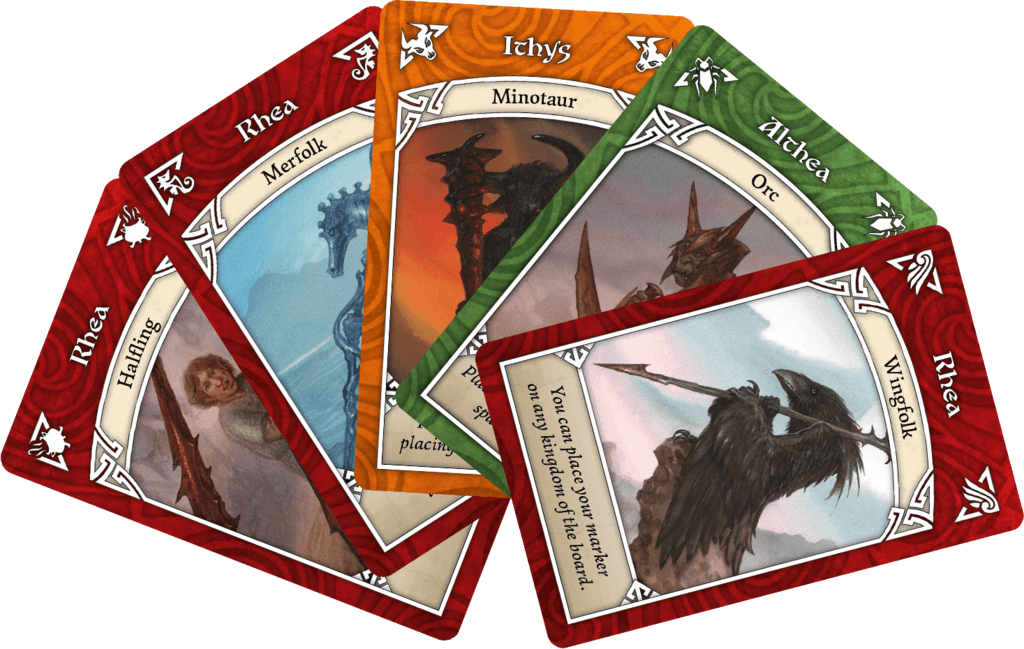
Yes, the art direction and design/layout work is very functional, but it just looks bad as a finished product. Ethnos looks like it was made in 1992. The card faces look like something you’d see on early CCGs (like Magic) or in the original Mystery Rummy card layout. I’m pretty sure that you can find college level design projects that would look better.
Despite this, Ethnos does overcome its shortfalls.
Fans of the Mystery Rummy games should find a LOT to enjoy in Ethnos. This type of gamer is probably already quite forgiving of mediocre components in lieu of solid game play. The concept of a variable rummy deck that promise a nearly limitless way to change up the game is a very appealing design feature. The obvious trade off here is that unlike the Mystery Rummy games, there is a bit of set up and tear down that must be taken into account. I think most adults have the patience to be able to set up and tear down games, so I’m going to say this is a non-issue.
Ethnos is a pretty simple game to teach. I haven’t even had to ask new players to watch the excellent video from Rodney Smith. Basic turn flow is exceptionally simple, and even the trickier elements are simple to teach by playing a quick sample round of the game. Emergent game play abounds thanks to the rules that restrict how control markers are added to the board. In later rounds of the game, players are often building much larger hands, and therefore must contend with larger pools of cards available to all players, whereas in early rounds, smaller sets and efficiency are of chief concern. The point here is that Ethnos has a rich depth in tactical and strategic complexity despite a very simple core rule set thanks in part to the fact that this is a game built on a rummy engine. In contrast to other rummy style games like Ticket To Ride, Ethnos embraces the simple core rules while adding just enough ways to break them to allow for satisfying and complex game play to emerge.
Ethnos is everything l like about Mystery Rummy (clever card play, interesting card powers, lightning fast pacing) without the things that bore me to tears about Ticket to Ride. If you enjoy the MIke Fitzgerald style Rummy games, Ethnos is a good buy for you. If you aren’t sure if you like rummy style games, I would suggest you check out any of the Mystery Rummy games first. If you are an area control game aficionado, you should be warned that this may not be your thing if you aren’t also into rummy type card games. Ethnos is ultimately a very odd duck. It’s an area control game without the plastic minis. It’s a CMON game that lacks the bling or visual polish that they are known for. It’s a rummy style card game that feels fresh and full of potential. Yeah, Ethnos is nothing like the game you would expect out of the box, but it succeeds as a very well designed game that is a joy to play even after putting several dozens of plays under your belt. BGG rating 8.0.

Scott Sexton
Scott Sexton is an avid boardgame enthusiast who regularly posts reviews on BoardGameGeek - You can subscribe to his Review Geeklist here and check out his contributions to Brawling Brothers here.

